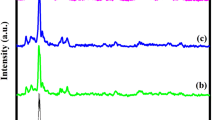Abstract
We discuss relationships between transparent supercapacitor performance and the morphology of its ZnO nanostructured electrodes. The electrodes with different morphologies were prepared by magnetron sputtering and postdeposition annealing. They were decorated with MnO2 nanostructures and tested in symmetric transparent supercapacitors. The capacitances for discharging at 10 µA/cm2 were in the range of 20–53 µF/cm2, meaning that an increase of 250% in capacitance can be obtained by optimizing the electrode morphology. Optimal morphologies were hierarchical with a large range of pore sizes available. The worst performing had the smallest range of pore sizes. Best devices exhibited transparencies above 90%.






Similar content being viewed by others
References
E. Fortunato, P. Barquinha, and R. Martins: Oxide semiconductor thin-film transistors: a review of recent advances. Adv. Mater. 24, 2945 (2012).
K. Gao, Z. Shao, X. Wu, X. Wang, Y. Zhang, W. Wang, and F. Wang: Paper-based transparent flexible thin film supercapacitors. Nanoscale 5, 5307 (2013).
J. Ge, G. Cheng, and L. Chen: Transparent and flexible electrodes and supercapacitors using polyaniline/single-walled carbon nanotube composite thin films. Nanoscale 3, 3084 (2011).
P. Kanninen, N. Dang Luong, L.H. Sinh, I.V. Anoshkin, A. Tsapenko, J. Seppälä, A.G. Nasibulin, and T. Kallio: Transparent and flexible highperformance supercapacitors based on single-walled carbon nanotube films. Nanotechnology 27, 235403 (2016).
X.Y. Liu, Y.Q. Gao, and G.W. Yang: A flexible, transparent and super-long-life supercapacitor based on ultrafine Co3O4 nanocrystal electrodes. Nanoscale 8, 4227 (2016).
M.A. Borysiewicz, M. Wzorek, M. Mysliwiec, J. Kaczmarski, and M. Ekielski: MnO2 ultrathin films deposited by means of magnetron sputtering: relationships between process conditions, structural properties and performance in transparent supercapacitors. Superlattices Microstruct. 100, 1213 (2016).
A. Lyubchyk, A. Vicente, P.U. Alves, B. Catela, B. Soule, T. Mateus, M. J. Mendes, H. Águas, E. Fortunato, and R. Martins: Influence of post‐dep-osition annealing on electrical and optical properties of ZnO‐based TCOs deposited at room temperature. Phys. Status Solidi A 213, 2317 (2016).
F. Beguin and E. Fra˛ckowiak: Supercapacitors: Materials, Systems and Applications, 1st reprint, (Wiley-VCH Verlag, Weinheim, 2013), p. 185.
M.A. Borysiewicz, T. Wojciechowski, E. Dynowska, E. Kaminska, and A. Piotrowska: Investigation of porous Zn growth mechnism during Zn reactive sputter deposition. Acta Phys. Polon. A 125, 1144 (2014).
M.A. Borysiewicz, E. Dynowska, V. Kolkovsky, J. Dyczewski, M. Wielgus, E. Kaminska, and A. Piotrowska: From porous to dense thin ZnO films through reactive DC sputter deposition onto Si (100) substrates. Phys. Status Solidi A 209, 2463 (2012).
M. Masłyk, M.A. Borysiewicz, M. Wzorek, T. Wojciechowski, M. Kwoka, and E. Kaminska: Influence of absolute argon and oxygen flow values at a constant ratio on the growth of Zn/ZnO nanostructures obtained by DC reactive magnetron sputtering. Appl. Surf. Sci. 389, 287 (2016).
A. Janotti and C.G. van de Walle: Fundamentals of zinc oxide as a semiconductor. Rep. Prog. Phys. 72, 126501 (2009).
Y. Luo: Preparation of MnO2 nanoparticles by directly mixing potassium permanganate and polyelectrolyte aqueous solutions. Mater. Lett. 61, 1893 (2007).
G. Wang, X. Lu, Y. Ling, T. Zhai, H. Wang, Y. Tong, and Y. Li: LiCl/PVA gel electrolyte stabilizes vanadium oxide nanowire electrodes for pseudoca-pacitors. ACS Nano 6, 10296 (2012).
H. Zhong, F. Xu, Z. Li, R. Fu, and D. Wu: High-energy supercapacitors based on hierarchical porous carbon with an ultrahigh ion-accessible surface area in ionic liquid electrolytes. Nanoscale 5, 4678 (2013).
S. Dutta, A. Bhaumik, and K.C-W. Wu: Hierarchically porous carbon derived from polymers and biomass: effect of interconnected pores on energy applications. Energy Environ. Sci. 7, 3574 (2014).
S. Leyva-García, D. Lozano-Castelló, E. Morallón, and D. Cazorla-Amorós: Silica-templated ordered mesoporous carbon thin films as electrodes for micro-capacitors. J. Mater. Chem. A 4, 4570 (2016).
S. Khalid, C. Cao, L. Wang, and Y. Zhu: Microwave assisted synthesis of porous NiCo2O4 microspheres: application as high performance asymmetric and symmetric supercapacitors with large areal capacitance. Sci. Rep. 6, 22699 (2016).
Project Web page: http://www.naczo.ite.waw.pl/en/home.html (accessed March 14, 2017).
Acknowledgment
This majority of this research was supported by the National Centre for Research and Development in the frames of the Lider V Programme through the project “Nanocoral zinc oxide-based supercapacitors for transparent electronics (NACZO)”, contract: LIDER/030/615/L-5/NCBR/2014.[19]
Author information
Authors and Affiliations
Corresponding author
Supplementary material
43579_2017_7020173_MOESM1_ESM.pdf
Controlling the Nanoscale Morphology and Structure of the ZnO/MnO2 System for Efficient Transparent Supercapacitor Electrodes
Rights and permissions
About this article
Cite this article
Borysiewicz, M.A., Wzorek, M., Ekielski, M. et al. Controlling the nanoscale morphology and structure of the ZnO/MnO2 system for efficient transparent supercapacitors. MRS Communications 7, 173–178 (2017). https://doi.org/10.1557/mrc.2017.16
Received:
Accepted:
Published:
Issue Date:
DOI: https://doi.org/10.1557/mrc.2017.16




